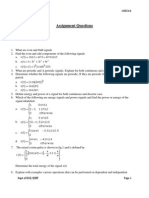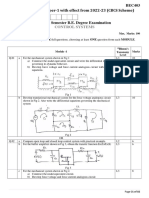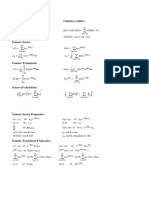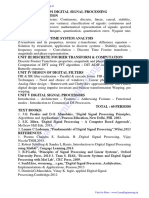0 ratings0% found this document useful (0 votes)
30 viewsConvolution 1
Uploaded by
Adnan AnirbanCopyright
© © All Rights Reserved
Available Formats
Download as PDF or read online on Scribd
0 ratings0% found this document useful (0 votes)
30 viewsConvolution 1
Uploaded by
Adnan AnirbanCopyright
© © All Rights Reserved
Available Formats
Download as PDF or read online on Scribd
You are on page 1/ 28
o analysis of nom-binear suplems
iu
© non-linear systems com alo be
Gpproximated ox dimear systerns
© tools Por omalysis of Yimear systems
abyss of near sy
axe well developed:
| eUnit impulse funckion cam be used to modal
io signal. both in CT or DT.
£2 hs property combed. with Vineanty &
tiene enuerriamce allows ux to express
| output to ong input im form of veaporut t
impulae input -
£ This procedac is called Convolution Fategad
im CT or Convolution Sum en OT
The output of 0 System cohen cmpulte
funckiom ts applied as am inpub is x()=8) [Let System
i
calted a8 Linputse Response (inground state)
=&(n) Tet system) vinl = h(n)
— |—_>
(inground state)
+
‘no initial conditions
% for t> Erapulie
x Cte) = fro B(b-tdt “Tespomae
fo Ltt System |_h(-)
. f (2) 8(r- ted “7 | (in ground state)! Tiare hrvartamte
=o
X= [AOE Od ej
sho t i -— ~—
aun (in ground state)
up” feo ae ER hati
fo
Conuolution. Entegra 3 x) [Ltt System | x) = x(4h()
ee
M4
OHA = Reontedde = {ie x-paeL__ Convolution
by
Properties of Convolution Operator mo
@ Time reversal
® Commutative Law @ Lirmits of. convolution ue ——ee—v—e
Hato: acteb c(t) & HCE) = yo
: ixCe) & nee) =4Ce)
© DVistribukive haw Phe: c
oO T t
x: O
O/p : trapezocal
herghk + 4x-3x min(4,5)
+48
Jimits : -3<¢<6
(i) sinzt *3(t-4) = Sinm(t-4) - sin(Tt-4n) ~ sinnt
t t-4 t-4 G4)
(ii) e** u(t) * u(t)
i ss [ro
(ii) eww) * w(t +5) : fesseoae - fe eX dc [=]
shift pres o/p © “eo
by +5
YO-£(1-€*) acess)
rity.
4 (1-e*) ue
(i) eZ u(t +3) * u(t-3) ety xutt) = 4 (l-e*)uco
Fe 2tts)
(ii) y(t) = cos mt u(t) * u(t - 3) ae+3) xu (E-3) = . C-e*)aw
Costtt w(t) * u(t)
~ | cosnt ude
~@
t
~ foancde sinnt
0 wT
Cosnt u(t) xu(t-3)= sinn(t-3)
Qum due = T
==sinnt uct-9)
qn 7 )
The convolution of the functions f,(t)=e2' u(t) and £,(t)=e' u(t) is equal to ......
f, ® fo = [po f.(¢-2de
/
7 ferue et Palt-ode
— a 0 T 2. The impulse response h{n] of the system is
oder: DT
If step response is 2e~‘u(t). Find the impulse response
Lovmesponse or output of. a.
system to @ Umit step
int
t
weo= [seode ; 8H du
L dt
“0
it
= [ mode 5 a= dete)
dt
We
SN
h®= 4 (zeus)
= -2e*u(t) + 26t 8)
for tro S(e)-0
h(E) = - 2eF uC)
Let s(t) be the step response of a linear system with zero initial conditions. Then tl
response of this system to an input wi
8) —>h®
ue) —= Ct)
afr
—| | s(t— \d ] = de
wr S] fis t)u(t)de hee sto
@) ['s@t-nucae
© f s—0[ f(s, Jae, Ja uo)—> [ic Dutode
(A) f.st-2 u(ode “
: . .% s(t-Da@de
‘ar ty
200
t hewn ty
The impulse response of a causal linear time invariant system is given as h(t).
Now consider the following two statements:
Statement (1): principle of superposition holds /
Statement (II): h(t)=0 for t<0. < comod
Which one of the following statements is correct?
(a) Statement (I) is correct and statement (II) is wrong.
(b) Statement (Il) is correct and statement (I) is wrong.
(c) Both Statement (1) and Statement (II) are wrong.
(& Both Statement (I) and Statement (Il) are correct.
Question-09
A signal e** sin (ct) is the input to a real Linear Time Invariant system. Given K and
¢ are constants, the output of the system will be of the from K e** sin (vt+x) where
{ef need not be equal to « but v equal to o.
(b) V need not be equal to w but B equal to a.
(0) Bequal to a and v equal to «.
(d) B need not be equal to « and v need not be equal to «.
LYE captem do net change fra. of:
sinusoids
A Linear Time Invariant system with an impulse response h(t) produces output
y(t) when input x(t) is applied. When the input x(t-1) is applied to a system with
impulse response h(t- 1); the output will be
(a) y(v)
(b) y(2(t- 0)
(c) y(t- 0)
a2 0
The impulse response of a system is h(t)=t u(t). For an input u(t-1), the output is
Ov &)
it
tucwaaty= fue» de
ut-1l) d)
tuck) ult-i)= Tue»
2
[The impulse response of a continuous time system is given by h(t)= 6(t-1)+5(t-
3). The value of the step response at t=2 is
(a) 0
of
(c) 2
(d) 3
t
s(t) = frou
+
= u(t-f) +u(t-s)
Ok t+2
8(2)= uC) +4)
= (4021
Consider an LTI system with impulse response h( u(t). If the output of the
system is y(t)=e** u(t)-e* u(t) then the input, x(t) is given by
(a) e* u(t) Laplace teancform
The impulse response g(t) of a system, G, is as shown in the figure (a). What is the
maximum value attained by the impulse response of two cascaded blocks of G as
shown in the figure (b)?
6 2
(fs
3 4 a
= Gs
5 ) tmpubse. ‘Tuporue
: qo G2
Qweck pubes equal.
peels
eaxk = ABT
= txtal= |
»
@ YOUR EXAM PREPARATION BUDDY (#8
@ONE STOP SOLUTION FOR ALLGATE)& ESE,
PSU'S AND OTHER STATE AE JE EXAMS
@ FOLLOW THE TEGELGRAM CHANNEL:
| @ DOWNLOAD THE EXAMDOST APP
5
To OE hese) fare
© +91-7089047561 &+91-7089047561 @ www.examdost.com > Download Exam
LAKSHYA GATE 2024 @
[ FEATURES: ,
@ CLASS NOTES DOWNLOADABLE AS PDF.
@ ALL SUBJECTS TO BE TAUGHT BY ANKIT GOYAL SIR
@Y SUBJECT WISE WORKBOOK INCLUDED
@ DEDICATED DOUBT-CLEARING SESSIONS, PRICE
@ WEEKLY TESTS wt
Mie ee LL
ere ae Rl
MTN
TRA Net tN ad tl) —-
ANKIT GOYAL SIR
© +91-708904756 1m D> Download Exam Dost App Luin
SNC ee
/ Price
=21,000/-
>» 20% PRICE DROP FOR FIRST 100 SUBSCRIBERS
> DISCOUNTED PRICE - 16,800 + GST
ONE MAN ARMY.
© +91-7089047561 ©+91-708904751
me
FITS)
ww.examdost.com D>
LS ACT dy)
Tee
xe 30.000/-)
Ne,
ee
>» 20% PRICE DROP FOR FIRST 100 SUBSCRIBERS
>» DISCOUNTED PRICE - 24,000 + GST
QUE MAN SRY gf ANKIT GOYAL SIR
7089047561 ©+81-7089047561 @ www.examdost.com > Download Exam Dost App.
ELECTRON GATE-2024
aay ke}
210,
para 148) 0) ae) Mee eet sd sty
> DISCOUNTED PRICE - (8,000 + GST
ONE MAN ARMY.
© +91-7089047561 @+91-7089047561 @
FIT RSS)
You might also like
- Signal and System Alan V. Oppenheim Notes of ch3No ratings yetSignal and System Alan V. Oppenheim Notes of ch311 pages
- Ece V Digital Signal Processing (10ec52) NotesNo ratings yetEce V Digital Signal Processing (10ec52) Notes161 pages
- Lab #3 Digital Images: A/D and D/A: Shafaq Tauqir 198292No ratings yetLab #3 Digital Images: A/D and D/A: Shafaq Tauqir 19829212 pages
- EENG 479: Digital Signal Processing: Student Name: IDNo ratings yetEENG 479: Digital Signal Processing: Student Name: ID12 pages
- Unit 3 Z-Transform and Its ImplementationNo ratings yetUnit 3 Z-Transform and Its Implementation120 pages
- Ece IV Signals & Systems (10ec44) Assignment0% (1)Ece IV Signals & Systems (10ec44) Assignment14 pages
- Signals and Systems: 18EC45 Model Question Paper-2 With Effect From 2019-20 (CBCS Scheme)No ratings yetSignals and Systems: 18EC45 Model Question Paper-2 With Effect From 2019-20 (CBCS Scheme)3 pages
- Time Domain Representation of Signals and SystemsNo ratings yetTime Domain Representation of Signals and Systems105 pages
- B. P. Lathi, Zhi Ding - Modern Digital and Analog Communication Systems-Oxford University Press (2009)No ratings yetB. P. Lathi, Zhi Ding - Modern Digital and Analog Communication Systems-Oxford University Press (2009)4 pages
- Discrete Fourier Series (DFS) and Discrete Fourier Transform (DFT)No ratings yetDiscrete Fourier Series (DFS) and Discrete Fourier Transform (DFT)49 pages
- Signal and System Alan V. Oppenheim Notes of ch1No ratings yetSignal and System Alan V. Oppenheim Notes of ch19 pages
- Department of Electrical Engineering EE365L: Communication SystemsNo ratings yetDepartment of Electrical Engineering EE365L: Communication Systems16 pages
- ECE 220 - Test 1 - E1309 Set-A: Each Question Is of 6 Marks. All Questions Are CompulsoryNo ratings yetECE 220 - Test 1 - E1309 Set-A: Each Question Is of 6 Marks. All Questions Are Compulsory1 page
- ECE411 - Problem Set 2 - DT Signals and SystemsNo ratings yetECE411 - Problem Set 2 - DT Signals and Systems10 pages
- UNIT- 3 Network - Communication Aspects in IOTNo ratings yetUNIT- 3 Network - Communication Aspects in IOT20 pages
- Basis Functions (3 Lectures) : Concept of Basis Functions. Fourier Transform and Its PropertiesNo ratings yetBasis Functions (3 Lectures) : Concept of Basis Functions. Fourier Transform and Its Properties16 pages
- Unit 3 Discrete Time Fourier Transform Questions and Answers - Sanfoundry PDFNo ratings yetUnit 3 Discrete Time Fourier Transform Questions and Answers - Sanfoundry PDF3 pages
- Digital Signal Processing (BEC-42) : Unit-3 Lecture-1 (FIR Filter Design)No ratings yetDigital Signal Processing (BEC-42) : Unit-3 Lecture-1 (FIR Filter Design)115 pages
- 227 39 Solutions Instructor Manual Chapter 1 Signals Systems100% (4)227 39 Solutions Instructor Manual Chapter 1 Signals Systems18 pages
- Singularity Functions: 1-2-1 The Unit-Step FunctionNo ratings yetSingularity Functions: 1-2-1 The Unit-Step Function22 pages
- l 5a Dsp Fir Optimal Method_filter Design MakNo ratings yetl 5a Dsp Fir Optimal Method_filter Design Mak6 pages
- Lab #3 Digital Images: A/D and D/A: Shafaq Tauqir 198292Lab #3 Digital Images: A/D and D/A: Shafaq Tauqir 198292
- EENG 479: Digital Signal Processing: Student Name: IDEENG 479: Digital Signal Processing: Student Name: ID
- Signals and Systems: 18EC45 Model Question Paper-2 With Effect From 2019-20 (CBCS Scheme)Signals and Systems: 18EC45 Model Question Paper-2 With Effect From 2019-20 (CBCS Scheme)
- B. P. Lathi, Zhi Ding - Modern Digital and Analog Communication Systems-Oxford University Press (2009)B. P. Lathi, Zhi Ding - Modern Digital and Analog Communication Systems-Oxford University Press (2009)
- Discrete Fourier Series (DFS) and Discrete Fourier Transform (DFT)Discrete Fourier Series (DFS) and Discrete Fourier Transform (DFT)
- Department of Electrical Engineering EE365L: Communication SystemsDepartment of Electrical Engineering EE365L: Communication Systems
- ECE 220 - Test 1 - E1309 Set-A: Each Question Is of 6 Marks. All Questions Are CompulsoryECE 220 - Test 1 - E1309 Set-A: Each Question Is of 6 Marks. All Questions Are Compulsory
- Basis Functions (3 Lectures) : Concept of Basis Functions. Fourier Transform and Its PropertiesBasis Functions (3 Lectures) : Concept of Basis Functions. Fourier Transform and Its Properties
- Unit 3 Discrete Time Fourier Transform Questions and Answers - Sanfoundry PDFUnit 3 Discrete Time Fourier Transform Questions and Answers - Sanfoundry PDF
- Digital Signal Processing (BEC-42) : Unit-3 Lecture-1 (FIR Filter Design)Digital Signal Processing (BEC-42) : Unit-3 Lecture-1 (FIR Filter Design)
- 227 39 Solutions Instructor Manual Chapter 1 Signals Systems227 39 Solutions Instructor Manual Chapter 1 Signals Systems
- Singularity Functions: 1-2-1 The Unit-Step FunctionSingularity Functions: 1-2-1 The Unit-Step Function







































































